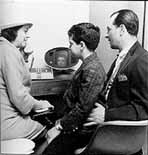
http://myhome.hanafos.com/~soonjp/vchx.html
Ever since the invention of the telephone , people have attempted to improve its quality, design, function and features. Quality video exchange is the one feature that has eluded innovators for over half a century.
Its logical to think that if a camera sends an image to a monitor via a wire then a camera/monitor –phone should be able to send an image and sound to another camera/ monitor phone.
Commercial systems were attempted in France and Germany during the 1930s but were not commercially feasible for the same reasons encountered decades later. Video carries a lot of signal information. Technically, moving video images requires more bandwidth than ordinary phone lines can accommodate.
.
AT&T's 1956 Picturephone could send a still image every two seconds. At the 1964 New York Worlds Fair the public experienced picture calls between special exhibits at Disneyland and the New York World's Fair.
The public felt the picture phone was too bulky; too many confusing buttons, and the picture was too small.
Following a six-year trial, a commercial Picture phone service was attempted in Pittsburgh in 1970, Consumer adoption was slow and never reached critical mass. The Picture phone was still big, expensive and there was research that showed many people did not want to be seen by the person they were talking with.
A Jetsons episode illustrated this notion when the character Jane, had her hair in curlers and did not want to be seen by the caller on her videophone. She used a mask of herself, at her best, to talk with the caller. This is an important social barrier that will hinder acceptance well into the future.
The Picture phone experiment in the USA during the early 1970s had been a failure. But by the 1990s four new factors had come together to make widespread videoconferencing possible. These were: the growing use of the personal computer (PC) placed a screen on virtually every desktop; falling prices for image capture devices connected to PCs making digital photography and video affordable; use of the Internet provided a low-cost means of connecting voice, images and people in real time over unlimited networks; and last - but not least - international standards ratified in 1996 and 1998 ensuring the compatibility of all equipment.
In fact, the first PC-based videophones were demonstrated by IBM and PictureTel as early as 1991 but the system was expensive and the image quality was mediocre at best.
Next week’s blog: Videoconferencing: ISDN to IP.
No comments:
Post a Comment